- Quick Read
- Deep Read ( 6 Min. )

Why is Christian Science in our name?
Our name is about honesty. The Monitor is owned by The Christian Science Church, and we’ve always been transparent about that.
The Church publishes the Monitor because it sees good journalism as vital to progress in the world. Since 1908, we’ve aimed “to injure no man, but to bless all mankind,” as our founder, Mary Baker Eddy, put it.
Here, you’ll find award-winning journalism not driven by commercial influences – a news organization that takes seriously its mission to uplift the world by seeking solutions and finding reasons for credible hope.
Explore values journalism About usIn Today’s Issue
- Court tells Netanyahu to fire ally, intensifying fight over democracy
- California storms: When a year’s worth of rain in two weeks isn’t enough
- Democracies survive outright assault, face internal threat
- Welcome back to college, pandemic students. This year is different.
- Cairo’s ‘Garbage City’ rebranded: It’s recycling ... and a living
Monitor Daily Podcast
- Follow us:
- Apple Podcasts
- Spotify
- RSS Feed
- Download
TODAY’S INTRO
Despite everything you think you know, journalism can be on the right track
 Mark Sappenfield
Mark Sappenfield
Have you read David Brooks’ latest article in The Atlantic? You should. It’s titled: “Despite Everything You Think You Know, America Is on the Right Track,” and you can read it here.
One main takeaway is this: It is essential not to mistake social upheaval with national weakness. Social upheaval is inevitable and in crucial ways can be a sign of strength. As Mr. Brooks says: “We go through moments when the established order stops working. People and movements rise up, and things change ... as new problems become obvious, the culture shifts.”
The world never stands still. Strength is measured by how well nations can evolve with it. “If there is one lesson from the events of the past year,” Mr. Brooks continues, “it is that open societies such as ours have an ability to adapt in a way that closed societies simply do not. Russia has turned violent and malevolent. China has grown more authoritarian and inept.”
The Monitor would argue that open societies are successful because they do the best job of protecting and expanding core human values – compassion, fairness, honesty, responsibility, ingenuity, and so on. That’s the idea behind our new values approach to news. If these are the things that really matter, shouldn’t the media be paying attention to them?
A friend of the Monitor, prize-winning journalist Mónica Guzmán, recently tweeted about our values approach: “It was so refreshing just to scan through this list. I can see dangers – sugarcoating, forcing problems into the shape of solutions... but … There’s something really promising here.”
Balancing hope and hard news has always been the Monitor’s challenge. But as Mr. Brooks compellingly shows, there are plentiful credible counterarguments to today’s doomscrolling. That starts with recognizing that progress is inherent in the highest ideals of humanity, and news is the story of our collective struggle to reach them.
Share this article
Link copied.

Help fund Monitor journalism for $11/ month
Already a subscriber? Login

Monitor journalism changes lives because we open that too-small box that most people think they live in. We believe news can and should expand a sense of identity and possibility beyond narrow conventional expectations.
Our work isn't possible without your support.
Court tells Netanyahu to fire ally, intensifying fight over democracy
Israel is facing a constitutional crisis, with the new government looking to make bold moves that could recast the judicial system. A new court decision points to the emerging battle lines.

-
By Neri Zilber Contributor
Other than Prime Minister Benjamin Netanyahu, the most consequential figure in Israeli politics today is Aryeh Deri, a senior minister in the country’s hard-right government and head of the ultra-Orthodox Shas party, Mr. Netanyahu’s biggest coalition partner.
His pivotal role in a brewing Israeli battle over democracy was confirmed on Wednesday. In a bombshell decision, the Israeli Supreme Court ruled Mr. Deri’s appointment as both interior and health minister was “unreasonable in the extreme” due to his repeated criminal convictions. And it instructed Mr. Netanyahu to fire him.
The case is a microcosm of a larger anticipated battle as the Netanyahu government pushes forward with plans to undermine the independence of institutions like the Supreme Court and, according to critics, hand unchecked power to the government.
Esther Hayut, chief justice of the Supreme Court, declared last week that the government’s plans would “deal a fatal blow” to the country’s democratic identity. Mr. Netanyahu’s partners reject talk of a constitutional crisis and maintain they are simply restoring “sovereignty” to the voters – as opposed to unelected and “activist” legal officials.
Analysts expect Mr. Netanyahu to uphold the court’s decision and fire Mr. Deri, although the case is expected to act as a catalyst for the broader judicial reforms already planned.
Court tells Netanyahu to fire ally, intensifying fight over democracy

Other than Prime Minister Benjamin Netanyahu, the most consequential figure in Israeli politics today is Aryeh Deri, a senior minister in the country’s hard-right religious and nationalist government and head of the ultra-Orthodox Shas party, Mr. Netanyahu’s biggest coalition partner.
His pivotal role in the political constellation that is testing the strength of Israel’s democratic institutions was confirmed Wednesday as the Israeli Supreme Court transformed a theoretical battle over Israeli democracy into a practical one early in the life of the three-week-old government.
In a not entirely unanticipated yet bombshell decision, it ruled that Mr. Deri’s appointment as both interior and health minister was “unreasonable in the extreme” due to his repeated criminal convictions. And it instructed Mr. Netanyahu to fire him.
The case is a microcosm of a larger anticipated battle as the Netanyahu government pushes forward with plans to radically alter the country’s judicial system, undermining the independence of institutions like the Supreme Court and, according to critics, likely handing unchecked power to the government and parliament.
In an unprecedented primetime speech last week, Esther Hayut, chief justice of the Supreme Court, declared that the government’s plans would “deal a fatal blow” to the country’s democratic identity. President Isaac Herzog, whose political power as a largely ceremonial head of state is limited, warned that a “historic constitutional crisis” is looming.
Already, tens of thousands of Israelis have taken to the streets of Tel Aviv and elsewhere in protest against the government, with more mass demonstrations planned.
“Will of the people”
Mr. Netanyahu’s coalition of Jewish ultranationalist and religious parties, which secured a 64-seat majority in the 120-seat Knesset in last November’s election, reject talk of a crisis and maintain that they are simply implementing the “will of the people” and restoring “sovereignty” to the voters – as opposed to unelected and “activist” legal officials.
This approach was on full display as coalition leaders responded swiftly to the Deri verdict, vowing in a statement late Wednesday to “correct the injustice and severe damage caused to the democratic [process] and the sovereignty of the people,” including “over two million citizens, the majority of the people, who voted for a government led by Benjamin Netanyahu in which Aryeh Deri will play a central and significant role.”

Mr. Deri, whose faction currently has 11 members in the Knesset, has been a mainstay in Israeli politics for over three decades. He has led the Shas party – its name is a Hebrew acronym for Sephardic Torah Guardians, indicating the ethnic base of its support – into nearly every governing coalition and personally filled senior cabinet posts. Yet legal troubles have bedeviled him since the late 1990s, when he was convicted of bribery and spent two years in jail. More recently, he pleaded guilty to tax fraud early last year and ostensibly promised the courts he would retire from public life in return for a lenient sentence.
The Supreme Court this week determined that it was “unreasonable” for a twice-convicted felon to serve as a cabinet minister and also that Mr. Deri had effectively misled the lower courts.
In their decision, the justices referred to Mr. Netanyahu’s powers as prime minister, writing: “Broad discretion does not mean unlimited discretion … even decisions concerning the appointment of ministers … are not immune from judicial review.”
Checks and balances
The Supreme Court’s independence and powers of judicial review are precisely what the Netanyahu government plans to curtail via legislation, including creating the ability to overrule the court’s decisions with a simple parliamentary majority and placing the judicial appointment process in the hands of the government.
“It’s hard to be more concerned,” says Professor Yaniv Roznai, a constitutional law expert at Reichman University, who calls the government’s proposed legislation “a terrible plan.”
“They will take away all the limits, like the courts and the ministerial legal advisers,” he says, “and then the government will have absolute power.”
The Israeli system of government lacks any effective checks and balances like a formal constitution, an upper house of parliament, a president with veto power, or a federal division of authorities, Professor Roznai notes.
“We have nothing, only one parliament controlled by the leadership of the coalition,” he adds. “It’s a blank check for the government.”
Legal and political analysts expect Prime Minister Netanyahu to uphold the court’s decision and fire Mr. Deri, although the case is expected to act as a catalyst for the broader judicial reforms already planned – which may now include, as a first order of business, trying to find a way to reappoint Mr. Deri as minister.
As one Shas parliamentarian put it prior to the verdict being announced, if the Supreme Court disqualified his party leader “it would be shooting itself in the head.”
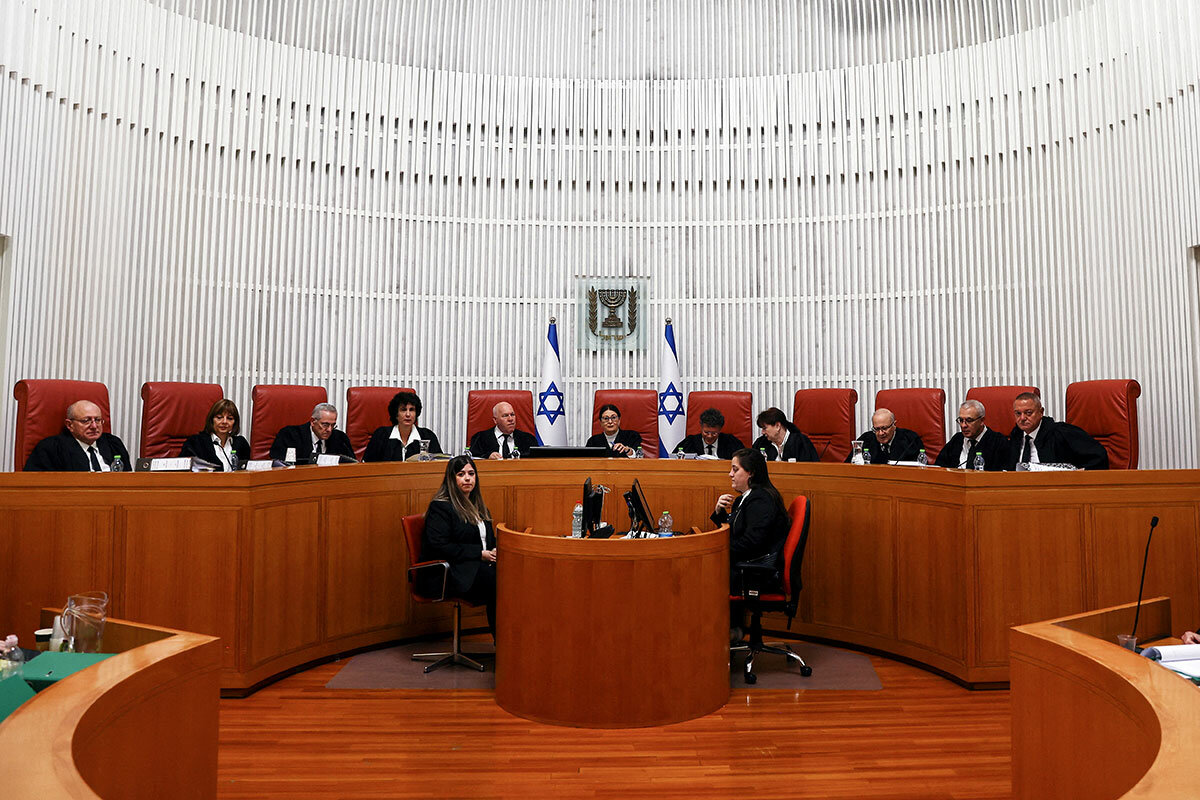
Yet for Mr. Netanyahu and his far-right and religious allies, the stakes clearly go further than just Mr. Deri.
“There are people who ideologically never wanted a strong power like the Supreme Court and legal system as a whole to limit what they want to do,” says Dan Meridor, a former justice minister from Mr. Netanyahu’s own Likud party who has become an outspoken critic of the prime minister.
“They don’t want limits on the power of the government and the majority [even] when it infringes on minority rights,” including instances involving illegal settlement construction in the West Bank, LGBTQ rights, or gender equity.
For Mr. Netanyahu the judicial reforms appear more personal. Analysts are convinced that subsequent steps will include weakening the post of the attorney general, the country’s highest legal official, with an eye to halting Mr. Netanyahu’s ongoing corruption trial on charges of bribery and fraud.
“Netanyahu loves Israel ... but he loves himself more,” adds Mr. Meridor, who served under Mr. Netanyahu for several years, including as a deputy prime minister. “When it comes to a conflict, he would destroy the system if [he believes] the system is after him.”
For opposition, few tools
Current and former legal officials, opposition leaders, and much of the public view the judicial reforms as a majoritarian power grab that would fundamentally alter Israel’s democratic system.
Yet legal experts are unconvinced that there are genuine political or legal tools to stop the Netanyahu government, save perhaps for a major public outcry. Last Saturday night an estimated 80,000 people demonstrated in the cold and the rain in Tel Aviv, amid Israeli and LGBTQ and Palestinian flags.
“You didn’t get a mandate to destroy our democracy,” read one sign with Mr. Netanyahu’s visage.
An even larger set of demonstrations is planned for this coming weekend in Tel Aviv and other cities, and civil society groups have begun pushing for a general strike, an unprecedented step in Israeli Jewish politics.
Mr. Netanyahu for now appears unmoved and undaunted, declaring earlier this week: “Two months ago there was a huge demonstration in Israel, the mother of all demonstrations: Millions of people took to the streets to vote in the election. … We received a mandate – and we will carry it out!”
However opinion polls going back over a decade conducted by the Israel Democracy Institute, a nonpartisan think tank, show majority public support for the Supreme Court having the ability to strike down “undemocratic” laws.
And in the case of Aryeh Deri, one poll taken by Channel 12 News this month was even more clear-cut: 65% of the public was against Mr. Deri being appointed a minister and only 22% was supportive, with even voters from Mr. Netanyahu’s own right-wing camp split on the question.
If the government does choose to press ahead with Mr. Deri’s reappointment, along with its wider agenda to overhaul the judicial system, there may come a moment in the coming weeks where a “real showdown and a huge [constitutional] crisis” between the branches of government will occur, warns Professor Roznai.
“I really hope we don’t find ourselves in that situation,” but rather that the independence and power of the courts and the rule of law are upheld, he says.
Mr. Deri, for his part, has pinned his hopes on what he perceives as the will of the people and the parliamentary majority enjoyed by his ally Mr. Netanyahu.
“If the door is locked, we’ll come in through the window. If the window is shut, we’ll break through the roof,” he said late Wednesday in his first response to the Supreme Court ruling. “It is good the court has had its say and that this [is] all over. [Now] the nation will judge, and we’ll see what happens.”

The Explainer
California storms: When a year’s worth of rain in two weeks isn’t enough
After weeks of massive rainstorms, California and the American West are grappling with how to manage flood risks, rebound from drought, and make new plans for the Colorado River Basin.
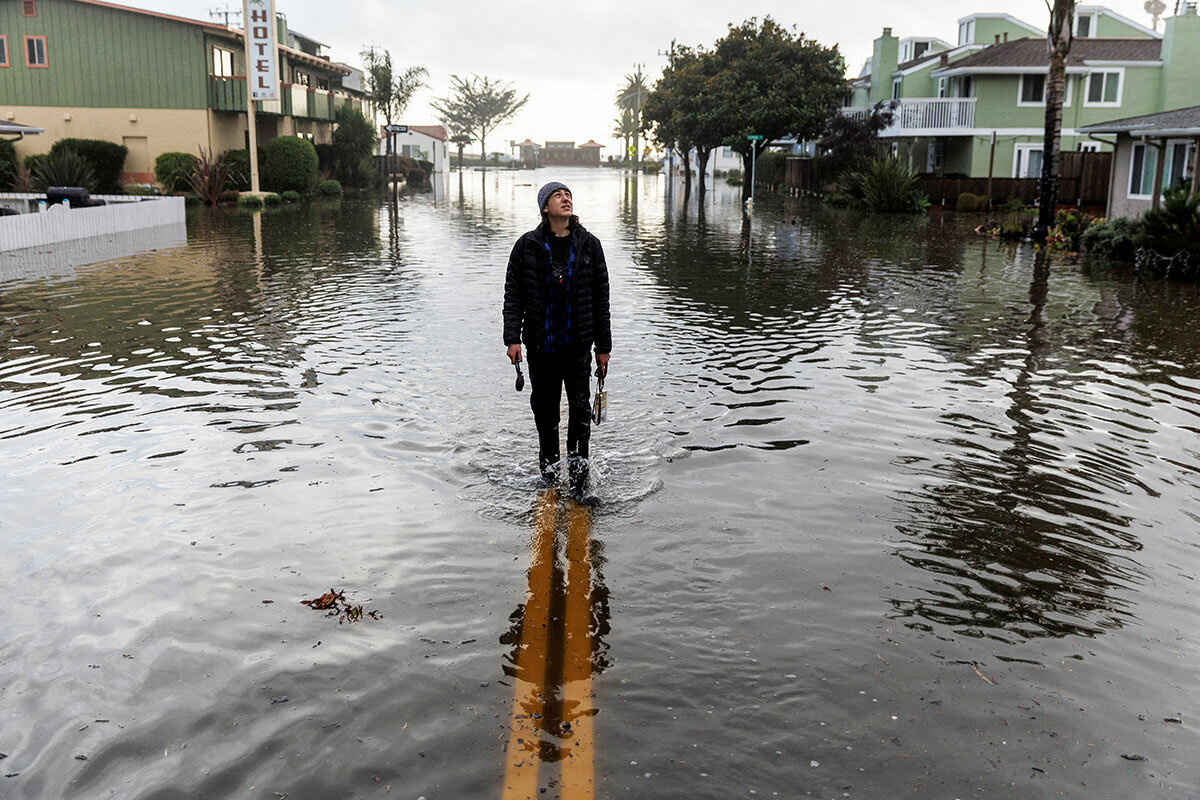
- Quick Read
- Deep Read ( 6 Min. )
As President Joe Biden heads to a sodden California Thursday, the state is trying to clean up after a series of storms dumped over a year’s worth of rainfall in under a month, causing at least 20 deaths and billions of dollars in damages.
One set of calculations estimates 25 trillion gallons of water fell across the state during the first two weeks of storms, which started Dec. 27. The series of atmospheric rivers – at least nine – that brought the deluge took forecasters by surprise, causing flood warnings for 90% of Californians and forcing tens of thousands of residents to evacuate their homes.
The California Geological Survey has mapped almost 600 mudslides since the storms began – a result of heavy rain on top of loose, dry landscapes and burn scars throughout the fire-prone state. Despite the destruction, rain is much-needed relief after three years of a drought so profound it is transforming the state. The relief is tempered, though, by how much more water California still needs.
As of Wednesday, 10% of the state’s monitored wells registered above-normal levels. Nearly two-thirds were below normal. “There are still major parts of the state which have exhausted effectively their groundwater supplies,” says Professor Paul Ullrich at the University of California, Davis.
California storms: When a year’s worth of rain in two weeks isn’t enough
As President Joe Biden heads to a sodden California Thursday, the state is trying to clean up after a series of storms dumped over a year’s worth of rainfall in under a month, causing at least 20 deaths and billions of dollars in damages.
One set of calculations estimates 25 trillion gallons of water fell across the state during the first two weeks of storms, which started Dec. 27. The series of atmospheric rivers – at least nine – that brought the deluge took forecasters by surprise, causing flood warnings for 90% of Californians and forcing tens of thousands of residents to evacuate their homes.
The California Geological Survey has mapped almost 600 mudslides since the storms began – a result of heavy rain on top of loose, dry landscapes and burn scars throughout the fire-prone state. Despite the destruction, rain is much-needed relief after three years of a drought so profound it is transforming the state. The relief is tempered, though, by how much more water California still needs.
Is California still in a drought?
Yes, and it's been unusually extreme, including two straight years with zero water deliveries to most Central Valley agricultural contractors and the first-ever shortage declaration in the Lower Colorado River Basin.
But now the drought has become less severe. Before the storms, 81% of the state was in severe drought, which adds stress on wildlife and trees, extends fire season, and results in insufficient pasture for livestock; 36% of the state was in extreme drought, with insufficient water for agriculture, wildlife, or urban use, and reservoirs so low their hydropower was limited; and 7% of the state was in exceptional drought – the severest category – which means native plants and animals start to die off, orchards need to be removed, and the area becomes prone to extensive fires.
As of Tuesday, essentially none of California was in a state of exceptional or extreme drought. Over 95% of it remained in moderate drought, and 46% in severe drought (categories overlap).
The massive deluge does not solve California’s long-term water needs, which are impacted by the changing climate conditions leading to more severe weather events, including drought.
Where is all this water going? Can it be stored and used later?
Some of the rainwater is flooding rivers, flowing out to sea, and washing into storm drains. “So even though we’re getting a lot of rain again, a lot of that water is unusable over the course of the year and basically contributes very little to our long-term water issues,” says Paul Ullrich, professor of regional and global climate modeling at the University of California, Davis.
But much of it is also making its way to the 1,500 reservoirs that, along with thousands of miles of canals, aqueducts, and rivers, make up the state’s water grid. While the vast majority of reservoirs are managed by local agencies and private companies, some 240 combine for 60% of the state’s water storage capacity – and those are managed by state and federal agencies.
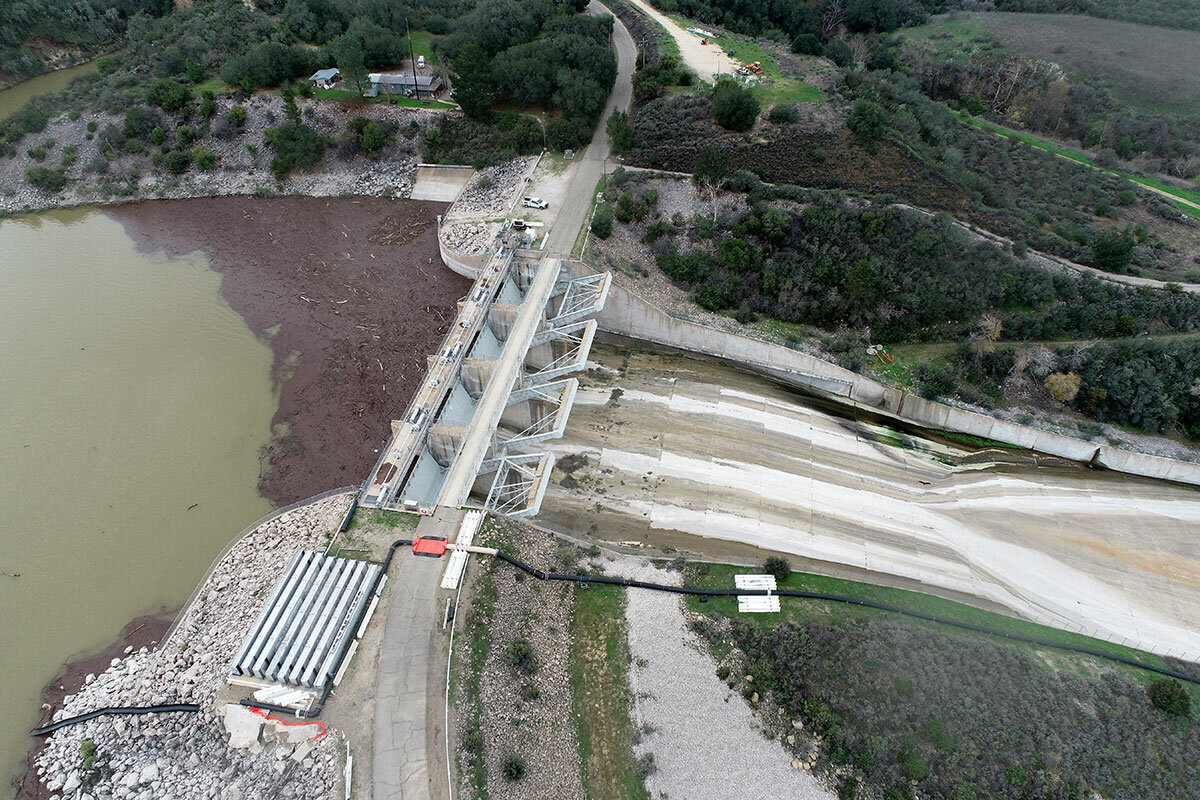
Eight of the state’s 17 major reservoirs have above-average water levels. California’s largest reservoir – Lake Shasta – is filled to just over half of capacity, and 83% of its historical average. Lake Oroville, the state’s second-largest reservoir, is slightly over the historical average, at 56% capacity. Trinity, which neighbors Lake Shasta about 200 miles north of Sacramento, is just 30% full.
Part of reservoirs’ job is to be ready for future deluges – so as they fill up, water is released from the dams to make space for more water. The right balance maximizes the amount of water the reservoirs retain while predicting how much room they’ll need for incoming storms or runoff. As weather predictions become more and more accurate, forecast-informed reservoir operations (FIRO) are helping guide the timing and amount of these releases. Local, state, and federal agencies are working together on FIRO initiatives at a handful of California reservoirs. On Tuesday, the U.S. Army Corps of Engineers, along with Sonoma Water, managed the first high-flow water release from the Coyote Valley Dam since the most recent drought started in 2020. The initiative is credited with taking the dam’s Lake Mendocino from completely dry three years ago to its highest water levels in at least a decade.
Smaller systems are probably in better shape than they were a month ago, as long as they were able to manage the aggressive water flows, according to Mike Anderson, state climatologist with the California Department of Water Resources. And a “lot of [larger systems] are ... recovering their conservation storage and maybe pivoting into a flood management role. So you have recovery there,” he said at a news briefing Monday.

National Weather Service, National Oceanic and Atmospheric Administration
Groundwater also plays a major part in the water grid, accounting for anywhere from 40% to 60% of the state’s water supply, depending on rainfall. The drier the year, the more water is needed from aquifers. Nearly 2 million wells provide water for rural households, agriculture, and the larger water grid. Those wells are running dry at record pace – posing serious risks to the communities that depend on them for drinking water, and to California’s $20 billion agriculture industry. Given California’s perennial drought, overpumping of aquifers has become a central concern, especially in the agriculture-driven Central Valley, which typically gets at least two-thirds of its water from underground, according to the Los Angeles Times.
The rain has helped recharge the aquifers, as it has reservoirs – but again, it’s not enough. As of Wednesday, 10% of the state’s monitored wells registered above-normal levels. Nearly two-thirds were below normal. “There are still major parts of the state which have exhausted effectively their groundwater supplies,” says Dr. Ullrich. This “makes it impossible ... to fall back on anything in case there’s any sort of water shortage.”
What about snow? Will that help?
Another indicator of long-term water supply is the snowpack, which builds up in winter and then runs into rivers, lakes, and reservoirs when it thaws throughout spring and summer.
California’s mountain regions have two to three times the average snowpack for this time of year – ahead of the record 1982-83 season (record keeping began in 1950). “Epic levels,” says Dr. Anderson, who points out that the snow’s impact on the water system remains to be seen. Peak snowmelt in the northern Sierra generally comes in April, and in the southern Sierra it can peak as late as June, he says. With much of winter still ahead, and the potential for more snowfall – but no guarantee – it’s too soon to know if the snowpack will cause more flooding when it melts.
Have the storms affected neighboring states – or the Colorado River Basin?
The atmospheric rivers stretched into Oregon and Washington state, and then moved east to the Rocky Mountains, where snow feeds the Colorado River. The Colorado River Basin provides water to 40 million people in seven states – Colorado, New Mexico, Utah, Wyoming, Nevada, Arizona, and California – and it’s running dangerously low. So low, those states have until Jan. 31 to come up with plans to reduce their water use, or the U.S. Bureau of Reclamation will step in and dictate the cuts. That deadline, and the need for states to drastically reduce their water use, have not been affected by the winter storms.
The Upper Basin has received more than 150% of median snowpack in some places. But “one wet season is not enough to fully resolve the river’s water issues,” said Erinann Saffell, state climatologist with the Arizona Department of Water Resources, via email.
Arizona gets about 35% of its water supply from the Colorado River Basin, with 60% coming from groundwater and Arizona rivers. The state’s short-term drought conditions have improved with the wet winter, but “Arizona remains in a long-term drought,” says Dr. Saffell.
While the swollen rivers recede in California, residents have a reprieve from water restrictions – and officials say not to get used to it. “We don’t know when the next drought is going to happen,” says Ryan Endean, assistant deputy director of communications for the California Department of Water Resources. “So we’re always encouraging Californians to be smart with their water usage. ... That’s just good practice going forward in California.”
Staff writer Francine Kiefer contributed to this report from Pasadena, California.

National Weather Service, National Oceanic and Atmospheric Administration

Patterns
Democracies survive outright assault, face internal threat
Violent attempts to overturn election results have failed in Washington, Brasilia, and Berlin. Now, democracies must survive an internal threat – extremists’ growing influence in mainstream parties.

- Quick Read
- Deep Read ( 4 Min. )
Democracy has come under fire several times in recent years: on Jan. 6, 2021, in Washington; earlier this month in Brasilia when mobs supporting another losing presidential candidate invaded government buildings; and in a foiled scheme in Germany to break into Parliament and detain ministers.
Yet in the United States, Brazil, and Germany, democracy has prevailed. Some observers worry that the real threat lies elsewhere, with far-right politicians who, just a few years ago, were seen as beyond the political pale but are now gaining sway in mainstream parties and government institutions.
They point to Hungary, where Hungarian Prime Minister Viktor Orban rules a country that is still nominally democratic, but where he has amassed controlling power. The European Union’s Parliament last year branded his government an “electoral autocracy.”
But even though formerly marginal extreme-right-wing figures have made progress in Sweden, France, and Italy (and won influence in the U.S. House of Representatives), there is no sign they are taking aim at the core pillars of democratic government.
In Israel, Benjamin Netanyahu’s far-right coalition allies pose perhaps the stiffest test of democratic resilience. After all, in Hungary it is an elected leader, not a mob, who has undermined bedrock democratic institutions.
Democracies survive outright assault, face internal threat

It’s the old horror-movie cliché: front door creaking, shutters banging, windows shattering... when the real danger is the intruder who’s already inside.
But it may also be the best way to understand a recent series of violent, extremist plots against major world democracies: the January 2021 assault on the U.S. Capitol and, in the past few weeks, a mob attack on government buildings in Brazil and a foiled scheme in Germany to break into the Bundestag and handcuff legislators and government ministers.
For despite the understandable alarm those events have caused, the more immediate challenge for democracies comes from within. Far-right politicians who, just a few years ago, were seen as beyond the political pale are gaining sway in mainstream parties and government institutions in America, Europe, and now in Israel as well.
Still, so far, in almost every developed country, the essential bedrocks of democracy – free and fair elections, unfettered news media, an independent judiciary and the rule of law – are holding fast.
That’s all the more remarkable because the world has been wrestling with multiple crises: a pandemic, a European war, and severe economic turbulence. Those threats have tested many people’s faith in their governing institutions, broadening the appeal of the strong-rule, anti-immigrant, anti-minority messages offered by the extreme right.
That, some fear, could lead some countries down the path forged by Hungarian Prime Minister Viktor Orban. He rules a country that is still nominally democratic. But he has gained control over most of the media, limited opposition parties’ opportunities to spread their messages, and constrained the independence of the judiciary and of university education. The European Union’s Parliament last year branded his government an “electoral autocracy.”

But Hungary remains an outlier, even though far-right parties have been making progress elsewhere.
In Scandinavia, the far-right Sweden Democrats have moved from being a fringe group to become the third largest group in parliament. Their votes are critical to the survival of the new center-right coalition government, which lacks a legislative majority.
Likewise in France, far-right leader Marine Le Pen last year won her highest vote share ever when she ran for the presidency a third time; in legislative elections a few weeks later her National Rally party became the largest opposition party in the national assembly.
In Italy, Giorgia Meloni, leader of a far-right party with its roots in the post-World War II neo-Fascism, became prime minister three months ago.
And the newly returned prime minister of Israel, Benjamin Netanyahu, has had to rely on small, extreme-right political parties to put together a governing coalition.
There are echoes of this process in the United States as well, dramatized by California congressman Kevin McCarthy’s agonizing path to become speaker of the House of Representatives this month.
His political fortunes rest on fellow Republicans whose views would once have been dismissed by party leaders as outlandish – especially their claim that the 2020 presidential election was “stolen” from former President Donald Trump.
But few of these hard-right legislators raised similar protests over the recent mid-term elections.
And in Europe, while newly prominent far-right politicians have pushed the immigration debate rightwards, there is no sign that they are taking aim at the core pillars of democratic government.
Mme. Le Pen has been using her influence in the French parliament to dédiaboliser – de-demonize – her party, drawing a veil over its neo-fascist origins and burnishing her governing credentials with an eye to the presidential election in four years’ time.

Italy’s Prime Minister Meloni has focused on passing a state budget. And despite the Italian far-right’s past chumminess with Vladimir Putin, she has reiterated support for Ukraine in the face of Russia’s invasion.
The sternest test of democratic resilience may come in Israel. Mr. Netanyahu’s far-right partners have raised the prospect of new Orthodox religious restrictions on public enterprises and leisure spaces, and floated the idea that doctors might be able to refuse treatment to LGBTQ patients.
But Mr. Netanyahu’s most controversial initiative would allow his Knesset majority to overrule decisions of the country’s Supreme Court – a key oversight institution in a nation with no written constitution.
Tens of thousands took to the streets last weekend to oppose the proposed law. Israel’s president warned of a possible “constitutional crisis.”
Mr. Netanyahu said there would be “deep discussion” in a parliamentary review committee before the law went ahead, and has pledged to safeguard democracy.
But his critics look with concern to Hungary, where it is an elected leader, not a mob attack, that has undermined bedrock institutions.
Their fear, to borrow from T.S. Eliot, is that democracy could end “not with a bang but a whimper.”

Welcome back to college, pandemic students. This year is different.
What’s the best way to help pandemic-era college students who arrived less prepared than previous years? Colleges add tutors, mental health resources – and a measure of grace.

- Quick Read
- Deep Read ( 6 Min. )
During the pandemic, colleges and universities made instructional, financial, and organizational pivots. But with high school graduation rates dropping and the national exam of fourth and eighth graders showing steep learning losses in math, many students are arriving on campus less prepared for the rigors of college. Mental health issues, anxiety, and a lack of study skills are common, and administrators say help is needed with everything from algebra to workload management.
Colleges are bolstering academic support, tutors, and mental health staff in an effort to help students reach the standards they need. Professors say they find themselves having to show grace – and worrying that if they show too much, they’ll hurt their students’ career prospects.
At the University of Maryland, Baltimore County, which focuses heavily on STEM, professors started noticing more withdrawals and low grades. Administrators added more college preparedness classes and hired at least 30 new academic tutors.
“What we’re seeing is that students may be coming with slightly lower preparation in math. We’re seeing students who maybe are coming with slightly lower high school GPAs than might have in previous years, because things were different in high school during online learning,” says Delana Gregg, director of academic learning resources, assessment, and analysis.
Welcome back to college, pandemic students. This year is different.
It has been challenging for Asia Alexander to gain perspective on how college used to be, pre-pandemic.
The 19-year-old Howard University sophomore doesn’t know how things used to be, frankly, because she was still in high school when COVID-19 hit. She finished her freshman year with a 3.8 GPA, attributed some to her smarts and some to a lighter workload. This school year, things changed.
“I just think the way the world shifted and coming back to college and the way the older teachers are trying to unshift it is really aggravating,” Ms. Alexander says. “We’re not used to doing regular school anymore.”
Ms. Alexander is one of many undergraduate students in the United States who spent their senior year distance learning during the pandemic. As learning and teaching changed in schools across the country, they had to learn both online and in person. School rituals changed, and some students got used to lighter workloads, which teachers doled out in hopes of not short-circuiting students’ brains amid a worldwide emergency.
Every college and university made instructional, financial, and organizational pivots. But with high school graduation rates dropping and the national exam of fourth and eighth graders showing steep learning losses in math in every state, many students are arriving on campus less prepared for the rigors of college. Mental health issues, social anxiety, and a lack of study skills are common, and faculty and administrators say help is needed with everything from algebra to workload management.
“What we’re seeing is that students may be coming with slightly lower preparation in math. We’re seeing students who maybe are coming with slightly lower high school GPAs than might have in previous years, because things were different in high school during online learning,” says Delana Gregg, director of academic learning resources, assessment, and analysis at the University of Maryland, Baltimore County.
During the first year of the pandemic, schools initially cut staff. Now, they are bolstering academic support, tutors, and mental health staff in an effort to help students reach the standards they need. Professors say they find themselves having to show grace – and worrying that if they show too much, they’ll hurt their students’ career prospects.
Learning while the entire system is stressed
At Wellesley College in Massachusetts, Kellie Carter Jackson felt like some of her students had lost hope. She saw a change in their energy level, concentration, and class participation. Instead of chalking up multiple blown deadlines to young people lacking discipline and not taking things seriously, she helped them journey on.
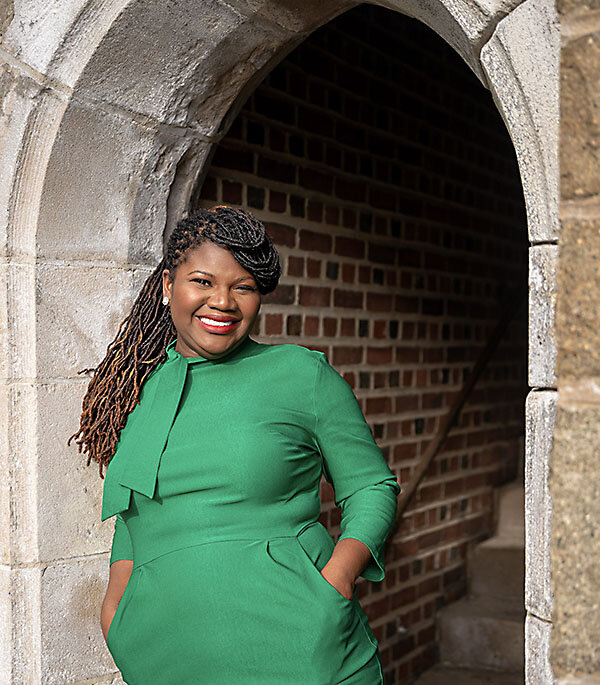
For example, when some of her students seemed unable to write a 15-to-20-page paper on the different manifestations of Black rebellions in the U.S. in the face of white supremacy, instead of giving F’s (unheard of for Wellesley students), she gave incompletes and long extensions.
“I think that preparedness and mental health go hand in hand, because I don’t think you can write that paper the way that it needs to be written if you are depressed, or you have anxiety, and a lot of these students do,” Dr. Carter Jackson says. For spring semester 2022, she had seven incompletes, including four in a class of eight students.
Ms. Alexander, the Howard student, agrees that the pandemic affected her mental health. Nothing was more difficult than her very first semester in Washington, D.C., in the fall of 2021. She was 900 miles away from her hometown of Tallahassee, Florida, and she wasn’t able to meet new people. Classes were online, dormitory visitation was suspended, and students tested weekly in order to eat in the cafeteria or go to the library or gymnasium.
“I know I’m not the only one who experienced that bad social experience last year. We were stuck in our rooms all day, it was really depressing,” she says.
With a scholarship to maintain, Ms. Alexander is working to duplicate the 3.8 GPA from freshman year, but the 3.5 she got last semester from a less desirable grade in a Spanish class was a gut punch to remind her that it won’t be as easy.
Freshman year “was like, ‘OK, you’re coming out of COVID. We’re not going to kill you,’ but this semester they’re literally trying to kill us,” Ms. Alexander moans exaggeratedly.
What does this crime scene look like? More tests. More demanding work. Less hand-holding. Zoom from the comfort of a dorm room has been replaced by hard deadlines.
“It’s been so long since I had to memorize something and present it in front of class,” she says. “And I hate paper tests. You can’t finesse them. You can’t get the easy way out on them.”
Still, when asked about her fall semester, Ms. Alexander says she would give it an 8 out of 10.
“Let’s figure out what’s not working”
At the University of Maryland, Baltimore County, which focuses heavily on STEM, professors started noticing more withdrawals and low grades. Administrators added more college preparedness classes and hired at least 30 new academic tutors.
Dr. Gregg’s office provides tutoring, study sessions, academic support courses, and academic advocacy. They offer five sections of a class called Academic Success for Lifelong Learning. Each section has 20 to 30 students, and it is recommended for new students who had a bad first or second semester.
“Essentially what the course does is, we tell students to take a breath. Let’s pause. Let’s figure out what’s not working. And let’s figure out how we can help you get connected to resources on campus and change behaviors so you can accomplish your goals,” Dr. Gregg says.
UMBC is seeing students with sets of strengths like resiliency, she adds. Students meet weekly for the course. They journal and reflect on what’s not working. They work on time management skills and how to study. They get connected to the counseling center and the financial aid office if money is an issue.
UMBC administrators forecast the pandemic’s effect on incoming students and hypothesized on how it would hurt retention if they didn’t act. They reformatted classes. One example: a freshman chemistry course with 300 students. The workload requires students to do a lot of work outside of class. The teacher restructured the class so each week students are essentially given benchmarks for how much to practice and study.
“At first they’re like, ‘Aw, how come you’re making us do all these practice problems,’ but then they get the quiz and they’re like, ‘Oh, this is why you wanted us to practice,’” Dr. Gregg says, laughing.
The fall 2021 freshmen class was 2,035 with a 95% retention rate. For fall 2022, 2,130 new students enrolled, which is a record.
At Wellesley, Dr. Carter Jackson sees some improvement – thankfully, she says, she didn’t have to give any incompletes for fall semester 2022. In the long term, she worries about what four years of giving grace to students would do to them when they graduate and are faced with finding jobs. Until that is figured out, she thinks the immediate calling for professors is to step up their instruction.
“I think there’s a way you can compel excellence out of someone, even in the midst of trying times,” she says.
How do you do that? She suggests teaching to the whole person and showing them the value of what they are learning – whether it’s poetry or molecular biology.
“It means not only do they have to step up as students,” she says, “but we have to step up as professors and show them the unity and the purpose behind what it is that they are learning.”

Cairo’s ‘Garbage City’ rebranded: It’s recycling ... and a living
For decades residents of one Cairo neighborhood were referred to as zabaleen, or garbage people. But today’s push for a green economy is creating opportunity and changing perceptions of their work.
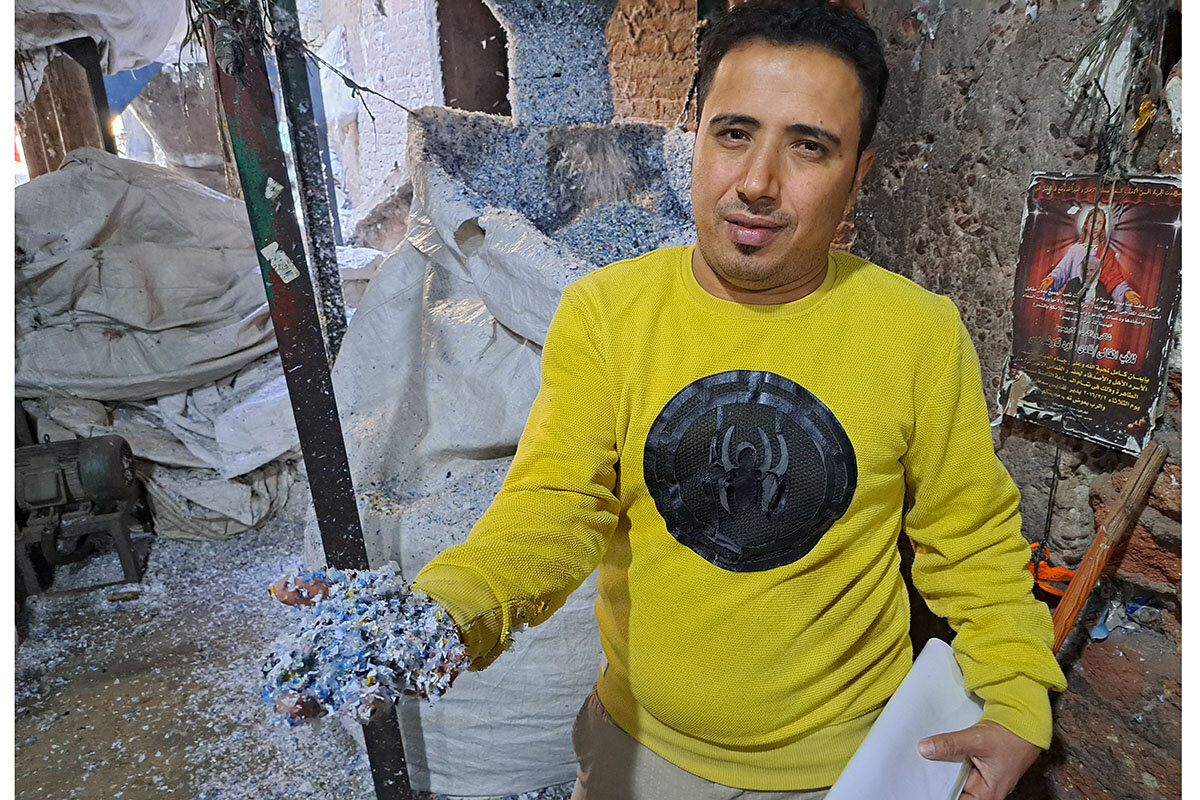
- Quick Read
- Deep Read ( 5 Min. )
In Manshiyat Naser, garbage is everywhere. Every day, more than 14,000 tons of it – 85% of all the waste produced by Cairo’s 22 million residents – passes through the neighborhood, where it is sorted, cleaned, and processed. And everyone here in this enclave of 70,000 people has a part to play.
“This is a resource, a hidden resource,” says Ibrahim Zahi, as he and his workers haul a stack of pressed plastic onto a pickup truck.
That one person’s trash is another’s treasure is a philosophy that was passed down to Mr. Zahi – and is powering his community’s emergence as the recycling capital of the Middle East. There is so much potential treasure, in fact, that 50 of his relatives work in recycling. “Waste has a value,” Mr. Zahi says. “Plastic here is just like oil and gold.”
By recovering what others cast away, residents in this long-stigmatized Cairo neighborhood are finding prosperity and a form of dignity.
“People always call us Garbage City and call us ‘garbage people,’” says resident Moussa Lazmy as he peers into a bundle of plastic bottles with a checklist in hand. “But this isn’t a city of garbage, this is a recycling city. Everything that comes through here has a purpose and is reused.”
Cairo’s ‘Garbage City’ rebranded: It’s recycling ... and a living
In the eastern Cairo neighborhood of Manshiyat Naser, garbage is everywhere: in the streets, piled up in alleyways, in the back of trucks, and even in the hallways of some people’s homes. Its smell is a constant companion.
For some, it’s the smell of opportunity.
“This is a resource, a hidden resource,” says resident Ibrahim Zahi, as he and his workers haul a five-foot stack of pressed plastic onto a grease-covered pickup truck.
One man’s trash is another man’s treasure. It might be a cliché, but it’s a philosophy passed down through generations to Mr. Zahi. And it’s the same ethos that is now powering his community’s emergence as the recycling capital of the Middle East.
There is so much potential treasure, in fact, that 50 of his relatives work in recycling.
“Waste has a value,” Mr. Zahi says. “Plastic here is just like oil and gold.”
By recovering what others cast away, residents in this Cairo enclave are finding something they say many overlook in their daily waste bin: prosperity and a form of dignity.
“People always call us Garbage City and call us ‘garbage people,’” says resident Moussa Lazmy as he peers into a 5-foot-tall bundle of plastic bottles with a checklist in hand. “But this isn’t a city of garbage, this is a recycling city. Everything that comes through here has a purpose and is reused.”

Recycling epicenter
In Manshiyat Naser, the garbage is constantly on the go, moving from station to station – a restless traveler heading to an eco-friendly destination.
More than 14,000 tons of mixed garbage passes through the neighborhood each day. That’s about 85% of all the waste produced by Cairo’s 22 million residents.
Here it is sorted, cleaned, processed, and converted into recycled plastic, or moved on to other factories as recycled raw materials for the production of other goods.
Everyone here in this enclave of 70,000 people has a part to play in the seven stages of recycling: collection, transport, sorting, crushing, washing, processing, and production. There are 8 different jobs involved in every ton of recycled plastic, employing entire families.
Behind Mr. Lazmy, women and teenagers sort mounds of discarded plastic bottles, bags, and other trash by hand in the street; later in the day it will be moved to several washing plants hidden in the honeycomb alleyways before being crushed and processed in the afternoon.
With the around-the-clock caravan of incoming trucks rumbling into Manshiyat Naser packed high with Cairo’s garbage, the hand-sorting, and the churning engines of washing and pressing plants, the sounds of recycling emit a distinctive hum.
New goals, changed perceptions
This predominately Coptic Christian community dates back to the 1920s, when families migrated from their home villages in Upper Egypt and set up camp on what was then the outskirts of Cairo, collecting garbage as feed for their pig farms and to sell as scrap.
Long-stigmatized by the public, for decades residents were referred to as the derogatory zabaleen, or garbage people.
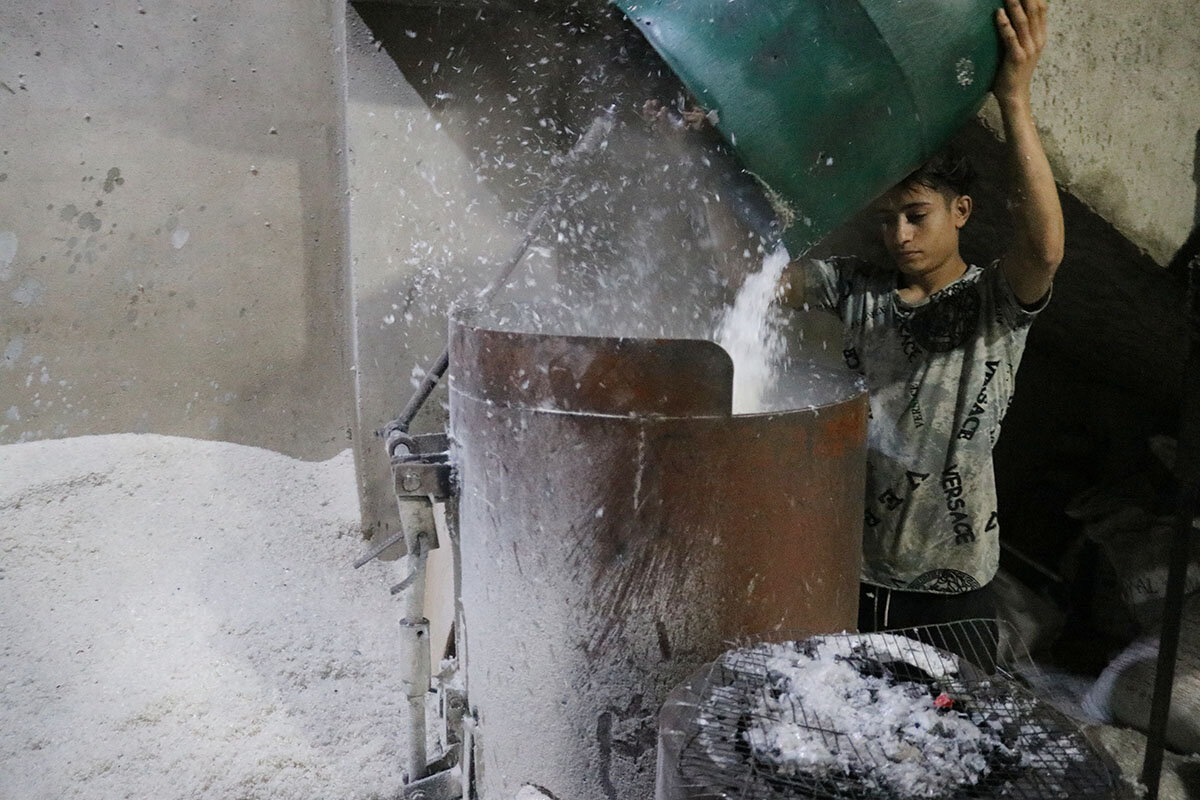
But with today’s push for a green economy, sustainability, and climate change awareness, many Egyptians are seeing a new value in the residents’ work, changing perceptions of this maligned neighborhood.
Others also see a business opportunity.
Since 2020, Swiss-multinational food company Nestlé has been working with area residents to collect processed polyethylene terephthalate – one of 100 types of plastic that come through the city – for its recycled rPET bottles.
Mr. Lazmy is one of Nestle’s coordinators, overseeing dozens of collectors, sorters, and processors to move thousands of tons of rPET plastic to a specialized production factory outside Cairo each week.
As Mr. Lazmy, smiling and gregarious, makes his rounds, there is little time for chit-chat; he has to ensure the proper amounts of color-sorted plastic are processed according to EU standards.
“This is the recycling capital of Egypt, and maybe the entire Middle East,” Mr. Lazmy says, counting bundles of crushed green plastic bottles. “It is a reason to feel pride, not shame.”
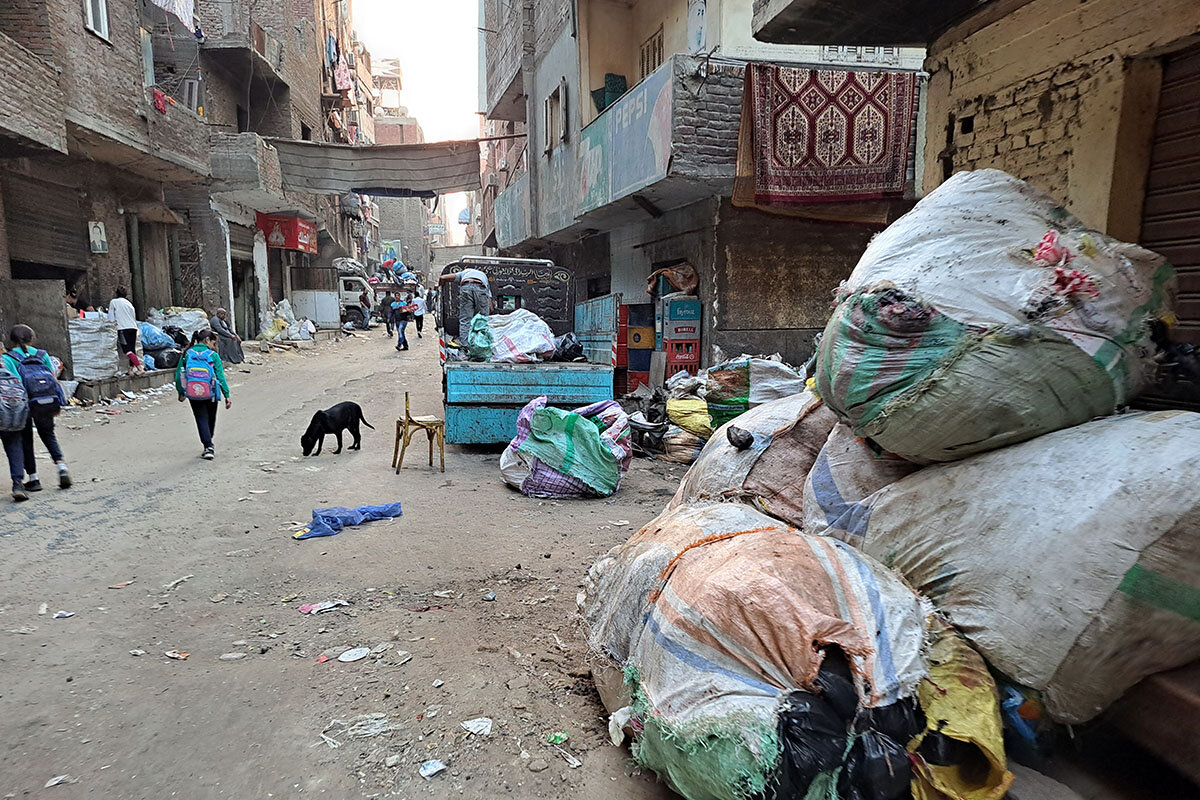
Ibrahim, 40, has worked his way up from a teenage garbage sorter to running his own workshop converting washed plastic pellets into clothes hangers used by dry cleaners and five-star hotels across Egypt.
The university graduate says recycling is not below his station.
“I am happy to contribute something to Egypt,” he says as he wipes his brow, eyes fixed on the churning machine molding plastic hangers. “We are making a living and fixing the climate in our own way. I am contributing to society.”
Those who go on to do well elsewhere often come back and reinvest in Recycling City; there are 22 resident-owned pressing and processing plants in the neighborhood.
Ibrahim Zahi worked in recycling in the United Arab Emirates before coming back to Manshiyat Naser, using the savings he earned in the oil-rich Gulf emirates to open his own pressing plant.
Now at his Brahim Zahi Company for Plastic, Mr. Zahi washes and presses plastic at two plants employing 10 area residents and exports recycled plastic bags and flip-flops abroad.
“I feel like an institution; people rely on me,” Mr. Zahi says at his factory.

The plastics market
Used plastic is so valuable that Manshiyat Naser residents buy and sell it to each other by the kilogram.
Along with everything in inflation-struck Egypt, the prices of shredded plastic are going up – as of late November it jumped to 25,000 Egyptian Pounds (about $860 dollars) per ton. Washed plastic pellets, highly desired for the production of a range of goods, doubled in price in 2022 alone.
“The recycling economy is like any economy. Even trash goes up in price when transportation and manpower are involved,” Magdy, a processor in his 20s, says as an automatic machine stretches black plastic and cuts it into trash bags.
“Because we here in Manshiyat recognize value in plastics, there is a market and assigned value to each material, which fluctuates.”
“We are entrepreneurs, not scavengers,” says Mr. Zahi.
Such ingenuity is on display at Manshiyat Naser’s Association for the Protection of the Environment, a nongovernmental organization and children’s center that provides educational activities and income for families funded by the creation of patchwork fabrics, rugs, and quilts sewn from unused scraps of fabric and cotton from Egypt’s garment factories.
On a November afternoon, area women were busy at looms, weaving multicolored tapestries and rugs.
“Recycling is not just about finding a new use for something used, there is an art to it,” says weaver Mariam, who gave only her first name, as she pushes the loom’s large wooden beater through the wool threads.
“From leftovers, we can all make something beautiful.”
Hamada Elrasam contributed to this report in Cairo.
Other headline stories we’re watching
(Get live updates throughout the day.)The Monitor's View
A leader’s parting grace
- Quick Read
- Deep Read ( 2 Min. )
-
By the Monitor's Editorial Board
One study of the pandemic found that the gender of a country’s leader did not make much difference in fighting COVID-19. Rather, a low death count depended mainly on particular traits, both feminine and masculine, within each society. The study was prompted in part because a few female leaders, such as New Zealand Prime Minister Jacinda Ardern, did make a huge difference. Her country had the lowest death rate in the Western world.
Ms. Ardern, who surprised her nation on Thursday by resigning after five years in office, helped emphasize this point about societywide values during her gracious exit speech. “I hope I leave New Zealanders with a belief that you can be kind but strong, empathetic but decisive, optimistic but focused,” she said.
If she leaves her fellow Kiwis with one leadership quality, it would be grace under fire, literally. Her empathy and compassion shone bright after a mass shooting by a gunman at two mosques and a violent eruption of Whakaari volcano.
Despite some missteps, Ms. Ardern has had certainty in the tangibility of leadership values, available to all. That boldness was matched by her humble grace, a gift to a nation that needed it during big crises.
A leader’s parting grace
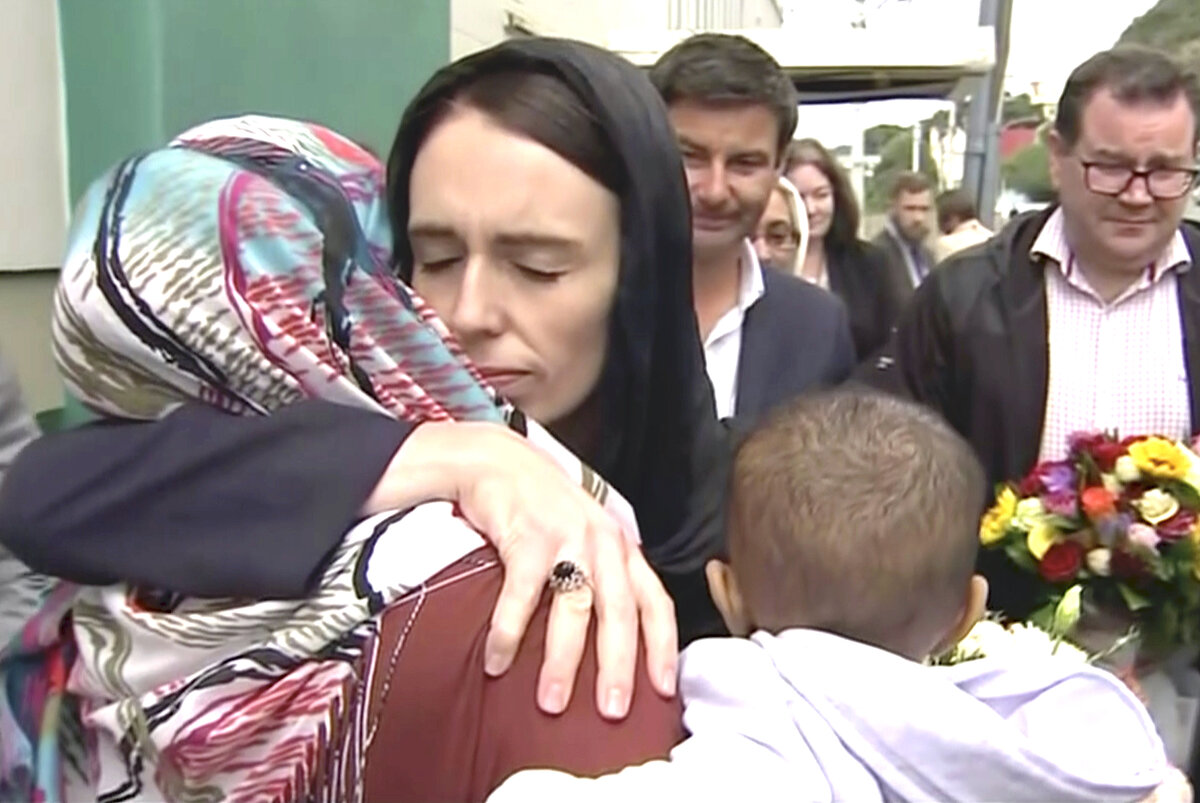
One study of the pandemic found that the gender of a country’s leader did not make much difference in fighting COVID-19. Rather, a low death count depended mainly on particular traits, both feminine and masculine, within each society. The study, conducted at the University of Memphis, was prompted in part because a few female leaders, such as New Zealand Prime Minister Jacinda Ardern, did make a huge difference. Her country had the lowest death rate in the Western world.
Ms. Ardern, who surprised her nation on Thursday by resigning after five years in office, helped emphasize this point about societywide values during her gracious exit speech.
“I hope I leave New Zealanders with a belief that you can be kind but strong, empathetic but decisive, optimistic but focused,” she said. “And that you can be your own kind of leader – one who knows when it’s time to go.”
She cited two qualities, courage and responsibility, in knowing when a leader is not “the right person to lead.” She and her ruling Labour Party have declined in popularity, and she admits she no longer has “enough in the tank” to do the job. She said her young daughter – born while Ms. Ardern was in office – and her fiancé have “sacrificed the most out of all of us.” That sort of transparency, marked by self-effacement, may be another of Ms. Ardern’s legacies.
If she leaves her fellow Kiwis with one leadership quality, it would be grace under fire, literally. Her empathy and compassion shone bright after a 2019 mass shooting by a gunman at two mosques and a violent eruption of Whakaari volcano in the same year. She also set up a commission to evaluate her government’s response to the coronavirus and recommend changes.
In her response to the mosque killings – which included her donning a headscarf while comforting victims’ families – she assured minorities that New Zealand represents diversity, kindness, and compassion.
“Those values will not and cannot be shaken by this attack,” she said.
Despite a few failed promises and some missteps, Ms. Ardern has had certainty in the tangibility of leadership values, available to all. That boldness was matched by her humble grace, a gift to a nation that needed it during a few big crises.

A Christian Science Perspective
Each weekday, the Monitor includes one clearly labeled religious article offering spiritual insight on contemporary issues, including the news. The publication – in its various forms – is produced for anyone who cares about the progress of the human endeavor around the world and seeks news reported with compassion, intelligence, and an essentially constructive lens. For many, that caring has religious roots. For many, it does not. The Monitor has always embraced both audiences. The Monitor is owned by a church – The First Church of Christ, Scientist, in Boston – whose founder was concerned with both the state of the world and the quality of available news.
Can God heal this?
- Quick Read
- Read or Listen ( 3 Min. )
-
By Moji George
No matter what kind of problem we’re facing or how intractable it may seem, we can rely on the Science of Christ, which reveals God’s unvarying, healing goodness and power.
Can God heal this?
For many people today, looking to God to heal their problems, including sickness, might be a new idea. Those who have witnessed God’s healing power in the past might be praying about an issue without seeing any improvement. In both cases, the question may arise, “Can God heal this?”
Whether seeking healing through prayer for the first time or facing a situation that is not yielding as previous problems have, especially if symptoms seem aggressive, it is certainly encouraging to remember that Christ Jesus healed “all manner of sickness and all manner of disease” (Matthew 4:23), and so did his disciples. But how does this help us with what feels like a very real, even urgent, need that we are experiencing now?
When I have felt this way, one fact that has always pierced fear, calmed a sense of panic, and uplifted my thought is that Christ-healing is based on a Science I can totally rely on. An experience I had years ago illustrates this. My son fell ill in the middle of the night with a virulent upset stomach. I was afraid, and though I prayed, running like a thread through my prayers was “Can God heal this?”
Then a thought came, gently but firmly, that I should pray from the basis of the Science of Christ. What a relief this was. I calmed down and felt God’s presence, which had been there all along but which my panicked praying had not recognized. I knew God’s creation is always as perfect as God the creator. I did not have to personally do or earn anything to make or keep it so.
The human picture changed at once. And I rejoiced in yet another proof of Christianly scientific healing.
What is this Science of Christ? The word “Science” hints at something that can’t vary – divine Truth. It is fixed, steady, and utterly reliable. This gives assurance of God’s ability and willingness to heal because God is the Principle of Science, the law of true existence that undergirds spiritual healing. Jesus’ unparalleled healing record was based on this Science – Christian Science, the Science of Truth – and his disciples also worked successfully from this basis.
Most importantly, Jesus promised that we too can witness God’s healing power today (see John 14:12).
The Science of Christ, revealing the unvarying goodness, steady love, and reliable law of God, came as divine revelation to Mary Baker Eddy. On this basis, she consistently proved over many years that God can heal “all manner of sickness and all manner of disease.” She wrote her revelation in “Science and Health with Key to the Scriptures,” inviting everyone to prove it for themselves. A glimmer of understanding can heal the most intractable human problem.
Jesus assures us that Truth makes free as we know it. So, our duty is to know the truth, and it is the truth, not us, that unfailingly brings freedom and healing. Studying God’s Word certainly helps us get better acquainted with God, to whom all things are possible. And becoming more familiar with Science and its rules found in Science and Health helps make this practical in our experience.
So, we can reach out to God with a heartfelt desire to know Him better. We can listen for the ideas God is giving as we study the Bible. If we listen, God will make sure that we hear. We will find out that the Science of Christ is available for all to learn and practice as we begin to accept the truth. God made us spiritually perfect, not materially imperfect. God does not cause evil. This is why it is destroyed.
We can know this truth at least to some degree. Science works according to an unchangeable, provable law. We can trust the outcome of our desires and obedience to God.
Ignorance of God produces discord. The right understanding of God, which Science teaches, restores health and harmony. Each one of us is, right now, an individual manifestation of God’s work, made and held perfect. This is the truth we can know, regardless of the evidence presented by the material senses.
I am finding that what is needed is a larger, more spiritual understanding of what God is. Problems pale into nothingness in the face of God’s infinitude, omnipotence, and love. What this means for the human situation is healing. So, yes, God can heal this.
Originally published as an editorial in the Christian Science Sentinel.

A message of love
Joy as a new year dawns

A look ahead
Thank you for joining us. Please come back tomorrow when Ann Scott Tyson looks at newly released data from China, revealing low GDP growth and the country’s first population dip since the 1960s. The numbers suggest the economic playing field with the United States may be leveling.


